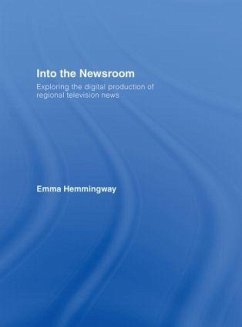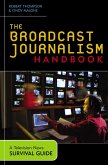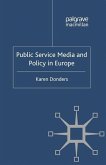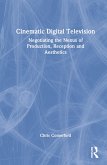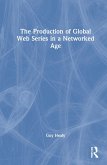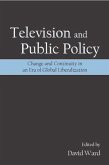- Gebundenes Buch
- Merkliste
- Auf die Merkliste
- Bewerten Bewerten
- Teilen
- Produkt teilen
- Produkterinnerung
- Produkterinnerung
Challenging orthodox readings of television news production,and ivestigating the processes of regional BBC news production, by adapting Actor Network Theory, Into the Newsroom provides a rigorous investigation of everyday rituals that are performed in the television newsroom.
Andere Kunden interessierten sich auch für
![The Broadcast Journalism Handbook The Broadcast Journalism Handbook]() Robert ThompsonThe Broadcast Journalism Handbook126,99 €
Robert ThompsonThe Broadcast Journalism Handbook126,99 €![Advertising and New Media Advertising and New Media]() Christina SpurgeonAdvertising and New Media180,99 €
Christina SpurgeonAdvertising and New Media180,99 €![Public Service Media and Policy in Europe Public Service Media and Policy in Europe]() K. DondersPublic Service Media and Policy in Europe38,99 €
K. DondersPublic Service Media and Policy in Europe38,99 €![Public Service Media and Policy in Europe Public Service Media and Policy in Europe]() K. DondersPublic Service Media and Policy in Europe38,99 €
K. DondersPublic Service Media and Policy in Europe38,99 €![Cinematic Digital Television Cinematic Digital Television]() Chris ComerfordCinematic Digital Television160,99 €
Chris ComerfordCinematic Digital Television160,99 €![The Production of Global Web Series in a Networked Age The Production of Global Web Series in a Networked Age]() Guy HealyThe Production of Global Web Series in a Networked Age180,99 €
Guy HealyThe Production of Global Web Series in a Networked Age180,99 €![Television and Public Policy Television and Public Policy]() David WardTelevision and Public Policy187,99 €
David WardTelevision and Public Policy187,99 €-
-
-
Challenging orthodox readings of television news production,and ivestigating the processes of regional BBC news production, by adapting Actor Network Theory, Into the Newsroom provides a rigorous investigation of everyday rituals that are performed in the television newsroom.
Hinweis: Dieser Artikel kann nur an eine deutsche Lieferadresse ausgeliefert werden.
Hinweis: Dieser Artikel kann nur an eine deutsche Lieferadresse ausgeliefert werden.
Produktdetails
- Produktdetails
- Verlag: Taylor & Francis
- Seitenzahl: 260
- Erscheinungstermin: 22. August 2007
- Englisch
- Abmessung: 234mm x 156mm x 16mm
- Gewicht: 544g
- ISBN-13: 9780415404679
- ISBN-10: 0415404673
- Artikelnr.: 45329563
- Herstellerkennzeichnung
- Libri GmbH
- Europaallee 1
- 36244 Bad Hersfeld
- gpsr@libri.de
- Verlag: Taylor & Francis
- Seitenzahl: 260
- Erscheinungstermin: 22. August 2007
- Englisch
- Abmessung: 234mm x 156mm x 16mm
- Gewicht: 544g
- ISBN-13: 9780415404679
- ISBN-10: 0415404673
- Artikelnr.: 45329563
- Herstellerkennzeichnung
- Libri GmbH
- Europaallee 1
- 36244 Bad Hersfeld
- gpsr@libri.de
Emma Hemmingway is Senior Lecturer in Journalism at the Centre for Broadcasting and Journalism at Nottingham Trent University. She previously worked for the BBC over a period of 12 years within a variety of roles, which included TV reporter, producer and also news editor.
Introduction: This will outline the main aims of the book which is to
identify, explore and develop an understanding of regional and local news
production, by adopting an alternative theoretical focus to the reading of
news. The purpose of a new theoretical focus is to examine the detailed
construction of news facts, to illustrate that news production is neither
dominated by ideologies that are slavishly followed by unwitting
journalists, nor manufactured by news organisations whose primary function
is to enhance the democratic potential of society. Internal routines,
self-reflexive practices, technological contingency and a plethora of
unstable and constantly changing practical constraints and opportunities
govern news production. Chapter One This will provide an over view of
existing literature and show how the argument of this book will differ in
both its practical and theoretical approach. It will outline traditional
studies of media production, as well as provide some context and
explanation of Actor Network Theory, and explain how this can enhance an
exploration of news. It will discuss some of the limitations of previous
studies of news production and explain how this book may offer an original
and more detailed explanation of news work. Chapter Two This will provide a
more detailed account of the ethnographic methods used for the research
carried out in the book. It will outline why the research was conducted in
particular environments, specific newsrooms and video journalism bureaux.
It will also discuss any methodological implications of the way in which
the research was carried out and the data gathered. It will also provide a
more detailed methodological rationale as to the use of ANT in reading
news. The chapter will also summarise my own experience as a BBC journalist
and producer, thus providing the empirical evidence with further
methodological validity. Chapter Three The following four chapters will be
specifically empirical, looking at separate aspects of regional news
production. This chapter provides an analysis of the digital infrastructure
of the BBC Nottingham newsroom, in particular the "media hub" - a digital
matrix through which all audio and video material is processed and
transmitted. It will explore the ramifications of operating a digital
central server and will provide observation and interviews with those who
use the hub, or who come into contact with it on a daily basis. Interviews
include production journalists, video journalists, media hub operators,
producers, directors and technicians. The chapter will also provide
diagrams and photographs of the newsroom and the digital matrix. Chapter
Four This chapter will be dedicated to an in depth study of the aggressive
implementation of video journalism, known as Personal, digital Production,
into the BBC regional newsroom in Nottingham. Nottingham has been chosen as
it has been selected by BBC Nations and Regions as the test bed for
developing video journalism more quickly than any other region. The chapter
will also incorporate two weeks observation and interviews at the BBC
training school in BBC Newcastle, where it will examine Michael Rosenblum's
training routine, including separate interviews with him and other BBC
trainers, as well as trainees attending the course and follow up interviews
when trainees have returned to their separate regions. It will then
concentrate on an analysis of how successfully Nottingham has adopted video
journalism production, examining managerial strategies and directives,
daily working practices, and how the new technology has affected the
existing news production set up. Using ANT as a theoretical tool, I will
explore how and in what way new technologies determine the alteration of
news agendas and the outcome of the final news product. Chapter Five This
chapter will concentrate on the development of the use of Live reporting,
paying particular attention to the effect of the technologies that are
being used, structuring the analysis in such a way that a team of satellite
truck operatives and separate journalists, producers and directors are
observed and interviewed during a week's daily operation of live
broadcasting. Chapter Six Having spent the last three chapters
concentrating on the more technological aspects of digital news production,
this chapter will be dedicated to the daily tasks and routines of the
journalists on the news production network. It will look at how they relate
to one another, how decisions are made, and changed, and how they interact
with the new technologies. It will also provide further analysis of the use
of ANT and critique certain aspects of ANT as a theoretical tool for
defining and exploring human action in the wake of digital technologies.
Chapter Seven This chapter will look at the development of the BBC pilot
project in Birmingham, paying particular attention to the use of the
associated digital technologies, the development of video journalism
training and opportunities, a second look at the BBC training centre in
Newcastle, and how the BBC Birmingham newsroom is adapted to provide a
local TV service. It will provide a comparative analysis of local TV in the
USA and in Europe and will involve observation of journalists and managers
in the UK and overseas, as well as interviews with those directly involved
in the BBC project. It will look at any earlier audience findings and
conclude with an analysis of the BBC's own decision as to whether or not to
extend the service throughout the BBC's regions. Conclusion The conclusion
will return to traditional readings of media effects and whilst
acknowledging their worth, will argue that this book has provided a
separate and original look at the mechanics of news production in the
digital age, pointing out further important technological developments- as
well as shown how a unique theoretical approach to exploring media, at the
specific level of practice, can greatly enhance out understanding of what
we all view on our TV screens.
identify, explore and develop an understanding of regional and local news
production, by adopting an alternative theoretical focus to the reading of
news. The purpose of a new theoretical focus is to examine the detailed
construction of news facts, to illustrate that news production is neither
dominated by ideologies that are slavishly followed by unwitting
journalists, nor manufactured by news organisations whose primary function
is to enhance the democratic potential of society. Internal routines,
self-reflexive practices, technological contingency and a plethora of
unstable and constantly changing practical constraints and opportunities
govern news production. Chapter One This will provide an over view of
existing literature and show how the argument of this book will differ in
both its practical and theoretical approach. It will outline traditional
studies of media production, as well as provide some context and
explanation of Actor Network Theory, and explain how this can enhance an
exploration of news. It will discuss some of the limitations of previous
studies of news production and explain how this book may offer an original
and more detailed explanation of news work. Chapter Two This will provide a
more detailed account of the ethnographic methods used for the research
carried out in the book. It will outline why the research was conducted in
particular environments, specific newsrooms and video journalism bureaux.
It will also discuss any methodological implications of the way in which
the research was carried out and the data gathered. It will also provide a
more detailed methodological rationale as to the use of ANT in reading
news. The chapter will also summarise my own experience as a BBC journalist
and producer, thus providing the empirical evidence with further
methodological validity. Chapter Three The following four chapters will be
specifically empirical, looking at separate aspects of regional news
production. This chapter provides an analysis of the digital infrastructure
of the BBC Nottingham newsroom, in particular the "media hub" - a digital
matrix through which all audio and video material is processed and
transmitted. It will explore the ramifications of operating a digital
central server and will provide observation and interviews with those who
use the hub, or who come into contact with it on a daily basis. Interviews
include production journalists, video journalists, media hub operators,
producers, directors and technicians. The chapter will also provide
diagrams and photographs of the newsroom and the digital matrix. Chapter
Four This chapter will be dedicated to an in depth study of the aggressive
implementation of video journalism, known as Personal, digital Production,
into the BBC regional newsroom in Nottingham. Nottingham has been chosen as
it has been selected by BBC Nations and Regions as the test bed for
developing video journalism more quickly than any other region. The chapter
will also incorporate two weeks observation and interviews at the BBC
training school in BBC Newcastle, where it will examine Michael Rosenblum's
training routine, including separate interviews with him and other BBC
trainers, as well as trainees attending the course and follow up interviews
when trainees have returned to their separate regions. It will then
concentrate on an analysis of how successfully Nottingham has adopted video
journalism production, examining managerial strategies and directives,
daily working practices, and how the new technology has affected the
existing news production set up. Using ANT as a theoretical tool, I will
explore how and in what way new technologies determine the alteration of
news agendas and the outcome of the final news product. Chapter Five This
chapter will concentrate on the development of the use of Live reporting,
paying particular attention to the effect of the technologies that are
being used, structuring the analysis in such a way that a team of satellite
truck operatives and separate journalists, producers and directors are
observed and interviewed during a week's daily operation of live
broadcasting. Chapter Six Having spent the last three chapters
concentrating on the more technological aspects of digital news production,
this chapter will be dedicated to the daily tasks and routines of the
journalists on the news production network. It will look at how they relate
to one another, how decisions are made, and changed, and how they interact
with the new technologies. It will also provide further analysis of the use
of ANT and critique certain aspects of ANT as a theoretical tool for
defining and exploring human action in the wake of digital technologies.
Chapter Seven This chapter will look at the development of the BBC pilot
project in Birmingham, paying particular attention to the use of the
associated digital technologies, the development of video journalism
training and opportunities, a second look at the BBC training centre in
Newcastle, and how the BBC Birmingham newsroom is adapted to provide a
local TV service. It will provide a comparative analysis of local TV in the
USA and in Europe and will involve observation of journalists and managers
in the UK and overseas, as well as interviews with those directly involved
in the BBC project. It will look at any earlier audience findings and
conclude with an analysis of the BBC's own decision as to whether or not to
extend the service throughout the BBC's regions. Conclusion The conclusion
will return to traditional readings of media effects and whilst
acknowledging their worth, will argue that this book has provided a
separate and original look at the mechanics of news production in the
digital age, pointing out further important technological developments- as
well as shown how a unique theoretical approach to exploring media, at the
specific level of practice, can greatly enhance out understanding of what
we all view on our TV screens.
Introduction: This will outline the main aims of the book which is to
identify, explore and develop an understanding of regional and local news
production, by adopting an alternative theoretical focus to the reading of
news. The purpose of a new theoretical focus is to examine the detailed
construction of news facts, to illustrate that news production is neither
dominated by ideologies that are slavishly followed by unwitting
journalists, nor manufactured by news organisations whose primary function
is to enhance the democratic potential of society. Internal routines,
self-reflexive practices, technological contingency and a plethora of
unstable and constantly changing practical constraints and opportunities
govern news production. Chapter One This will provide an over view of
existing literature and show how the argument of this book will differ in
both its practical and theoretical approach. It will outline traditional
studies of media production, as well as provide some context and
explanation of Actor Network Theory, and explain how this can enhance an
exploration of news. It will discuss some of the limitations of previous
studies of news production and explain how this book may offer an original
and more detailed explanation of news work. Chapter Two This will provide a
more detailed account of the ethnographic methods used for the research
carried out in the book. It will outline why the research was conducted in
particular environments, specific newsrooms and video journalism bureaux.
It will also discuss any methodological implications of the way in which
the research was carried out and the data gathered. It will also provide a
more detailed methodological rationale as to the use of ANT in reading
news. The chapter will also summarise my own experience as a BBC journalist
and producer, thus providing the empirical evidence with further
methodological validity. Chapter Three The following four chapters will be
specifically empirical, looking at separate aspects of regional news
production. This chapter provides an analysis of the digital infrastructure
of the BBC Nottingham newsroom, in particular the "media hub" - a digital
matrix through which all audio and video material is processed and
transmitted. It will explore the ramifications of operating a digital
central server and will provide observation and interviews with those who
use the hub, or who come into contact with it on a daily basis. Interviews
include production journalists, video journalists, media hub operators,
producers, directors and technicians. The chapter will also provide
diagrams and photographs of the newsroom and the digital matrix. Chapter
Four This chapter will be dedicated to an in depth study of the aggressive
implementation of video journalism, known as Personal, digital Production,
into the BBC regional newsroom in Nottingham. Nottingham has been chosen as
it has been selected by BBC Nations and Regions as the test bed for
developing video journalism more quickly than any other region. The chapter
will also incorporate two weeks observation and interviews at the BBC
training school in BBC Newcastle, where it will examine Michael Rosenblum's
training routine, including separate interviews with him and other BBC
trainers, as well as trainees attending the course and follow up interviews
when trainees have returned to their separate regions. It will then
concentrate on an analysis of how successfully Nottingham has adopted video
journalism production, examining managerial strategies and directives,
daily working practices, and how the new technology has affected the
existing news production set up. Using ANT as a theoretical tool, I will
explore how and in what way new technologies determine the alteration of
news agendas and the outcome of the final news product. Chapter Five This
chapter will concentrate on the development of the use of Live reporting,
paying particular attention to the effect of the technologies that are
being used, structuring the analysis in such a way that a team of satellite
truck operatives and separate journalists, producers and directors are
observed and interviewed during a week's daily operation of live
broadcasting. Chapter Six Having spent the last three chapters
concentrating on the more technological aspects of digital news production,
this chapter will be dedicated to the daily tasks and routines of the
journalists on the news production network. It will look at how they relate
to one another, how decisions are made, and changed, and how they interact
with the new technologies. It will also provide further analysis of the use
of ANT and critique certain aspects of ANT as a theoretical tool for
defining and exploring human action in the wake of digital technologies.
Chapter Seven This chapter will look at the development of the BBC pilot
project in Birmingham, paying particular attention to the use of the
associated digital technologies, the development of video journalism
training and opportunities, a second look at the BBC training centre in
Newcastle, and how the BBC Birmingham newsroom is adapted to provide a
local TV service. It will provide a comparative analysis of local TV in the
USA and in Europe and will involve observation of journalists and managers
in the UK and overseas, as well as interviews with those directly involved
in the BBC project. It will look at any earlier audience findings and
conclude with an analysis of the BBC's own decision as to whether or not to
extend the service throughout the BBC's regions. Conclusion The conclusion
will return to traditional readings of media effects and whilst
acknowledging their worth, will argue that this book has provided a
separate and original look at the mechanics of news production in the
digital age, pointing out further important technological developments- as
well as shown how a unique theoretical approach to exploring media, at the
specific level of practice, can greatly enhance out understanding of what
we all view on our TV screens.
identify, explore and develop an understanding of regional and local news
production, by adopting an alternative theoretical focus to the reading of
news. The purpose of a new theoretical focus is to examine the detailed
construction of news facts, to illustrate that news production is neither
dominated by ideologies that are slavishly followed by unwitting
journalists, nor manufactured by news organisations whose primary function
is to enhance the democratic potential of society. Internal routines,
self-reflexive practices, technological contingency and a plethora of
unstable and constantly changing practical constraints and opportunities
govern news production. Chapter One This will provide an over view of
existing literature and show how the argument of this book will differ in
both its practical and theoretical approach. It will outline traditional
studies of media production, as well as provide some context and
explanation of Actor Network Theory, and explain how this can enhance an
exploration of news. It will discuss some of the limitations of previous
studies of news production and explain how this book may offer an original
and more detailed explanation of news work. Chapter Two This will provide a
more detailed account of the ethnographic methods used for the research
carried out in the book. It will outline why the research was conducted in
particular environments, specific newsrooms and video journalism bureaux.
It will also discuss any methodological implications of the way in which
the research was carried out and the data gathered. It will also provide a
more detailed methodological rationale as to the use of ANT in reading
news. The chapter will also summarise my own experience as a BBC journalist
and producer, thus providing the empirical evidence with further
methodological validity. Chapter Three The following four chapters will be
specifically empirical, looking at separate aspects of regional news
production. This chapter provides an analysis of the digital infrastructure
of the BBC Nottingham newsroom, in particular the "media hub" - a digital
matrix through which all audio and video material is processed and
transmitted. It will explore the ramifications of operating a digital
central server and will provide observation and interviews with those who
use the hub, or who come into contact with it on a daily basis. Interviews
include production journalists, video journalists, media hub operators,
producers, directors and technicians. The chapter will also provide
diagrams and photographs of the newsroom and the digital matrix. Chapter
Four This chapter will be dedicated to an in depth study of the aggressive
implementation of video journalism, known as Personal, digital Production,
into the BBC regional newsroom in Nottingham. Nottingham has been chosen as
it has been selected by BBC Nations and Regions as the test bed for
developing video journalism more quickly than any other region. The chapter
will also incorporate two weeks observation and interviews at the BBC
training school in BBC Newcastle, where it will examine Michael Rosenblum's
training routine, including separate interviews with him and other BBC
trainers, as well as trainees attending the course and follow up interviews
when trainees have returned to their separate regions. It will then
concentrate on an analysis of how successfully Nottingham has adopted video
journalism production, examining managerial strategies and directives,
daily working practices, and how the new technology has affected the
existing news production set up. Using ANT as a theoretical tool, I will
explore how and in what way new technologies determine the alteration of
news agendas and the outcome of the final news product. Chapter Five This
chapter will concentrate on the development of the use of Live reporting,
paying particular attention to the effect of the technologies that are
being used, structuring the analysis in such a way that a team of satellite
truck operatives and separate journalists, producers and directors are
observed and interviewed during a week's daily operation of live
broadcasting. Chapter Six Having spent the last three chapters
concentrating on the more technological aspects of digital news production,
this chapter will be dedicated to the daily tasks and routines of the
journalists on the news production network. It will look at how they relate
to one another, how decisions are made, and changed, and how they interact
with the new technologies. It will also provide further analysis of the use
of ANT and critique certain aspects of ANT as a theoretical tool for
defining and exploring human action in the wake of digital technologies.
Chapter Seven This chapter will look at the development of the BBC pilot
project in Birmingham, paying particular attention to the use of the
associated digital technologies, the development of video journalism
training and opportunities, a second look at the BBC training centre in
Newcastle, and how the BBC Birmingham newsroom is adapted to provide a
local TV service. It will provide a comparative analysis of local TV in the
USA and in Europe and will involve observation of journalists and managers
in the UK and overseas, as well as interviews with those directly involved
in the BBC project. It will look at any earlier audience findings and
conclude with an analysis of the BBC's own decision as to whether or not to
extend the service throughout the BBC's regions. Conclusion The conclusion
will return to traditional readings of media effects and whilst
acknowledging their worth, will argue that this book has provided a
separate and original look at the mechanics of news production in the
digital age, pointing out further important technological developments- as
well as shown how a unique theoretical approach to exploring media, at the
specific level of practice, can greatly enhance out understanding of what
we all view on our TV screens.

